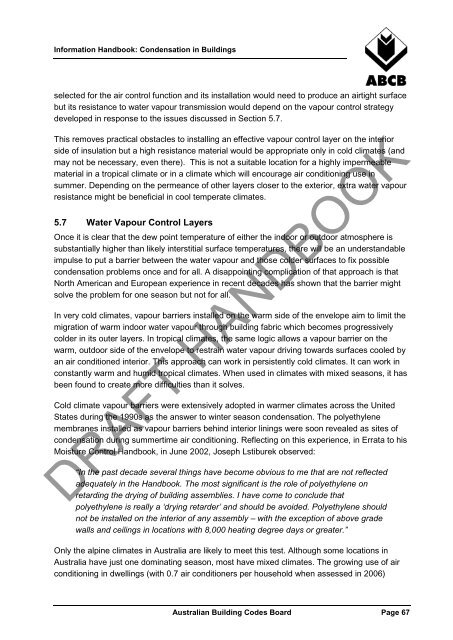Condensation in Buildings - Australian Building Codes Board
Condensation in Buildings - Australian Building Codes Board
Condensation in Buildings - Australian Building Codes Board
Create successful ePaper yourself
Turn your PDF publications into a flip-book with our unique Google optimized e-Paper software.
Information Handbook: <strong>Condensation</strong> <strong>in</strong> Build<strong>in</strong>gs<br />
selected for the air control function and its <strong>in</strong>stallation would need to produce an airtight surface<br />
but its resistance to water vapour transmission would depend on the vapour control strategy<br />
developed <strong>in</strong> response to the issues discussed <strong>in</strong> Section 5.7.<br />
This removes practical obstacles to <strong>in</strong>stall<strong>in</strong>g an effective vapour control layer on the <strong>in</strong>terior<br />
side of <strong>in</strong>sulation but a high resistance material would be appropriate only <strong>in</strong> cold climates (and<br />
may not be necessary, even there). This is not a suitable location for a highly impermeable<br />
material <strong>in</strong> a tropical climate or <strong>in</strong> a climate which will encourage air condition<strong>in</strong>g use <strong>in</strong><br />
summer. Depend<strong>in</strong>g on the permeance of other layers closer to the exterior, extra water vapour<br />
resistance might be beneficial <strong>in</strong> cool temperate climates.<br />
5.7 Water Vapour Control Layers<br />
Once it is clear that the dew po<strong>in</strong>t temperature of either the <strong>in</strong>door or outdoor atmosphere is<br />
substantially higher than likely <strong>in</strong>terstitial surface temperatures, there will be an understandable<br />
impulse to put a barrier between the water vapour and those colder surfaces to fix possible<br />
condensation problems once and for all. A disappo<strong>in</strong>t<strong>in</strong>g complication of that approach is that<br />
North American and European experience <strong>in</strong> recent decades has shown that the barrier might<br />
solve the problem for one season but not for all.<br />
In very cold climates, vapour barriers <strong>in</strong>stalled on the warm side of the envelope aim to limit the<br />
migration of warm <strong>in</strong>door water vapour through build<strong>in</strong>g fabric which becomes progressively<br />
colder <strong>in</strong> its outer layers. In tropical climates, the same logic allows a vapour barrier on the<br />
warm, outdoor side of the envelope to restra<strong>in</strong> water vapour driv<strong>in</strong>g towards surfaces cooled by<br />
an air conditioned <strong>in</strong>terior. This approach can work <strong>in</strong> persistently cold climates. It can work <strong>in</strong><br />
constantly warm and humid tropical climates. When used <strong>in</strong> climates with mixed seasons, it has<br />
been found to create more difficulties than it solves.<br />
Cold climate vapour barriers were extensively adopted <strong>in</strong> warmer climates across the United<br />
States dur<strong>in</strong>g the 1990s as the answer to w<strong>in</strong>ter season condensation. The polyethylene<br />
membranes <strong>in</strong>stalled as vapour barriers beh<strong>in</strong>d <strong>in</strong>terior l<strong>in</strong><strong>in</strong>gs were soon revealed as sites of<br />
condensation dur<strong>in</strong>g summertime air condition<strong>in</strong>g. Reflect<strong>in</strong>g on this experience, <strong>in</strong> Errata to his<br />
Moisture Control Handbook, <strong>in</strong> June 2002, Joseph Lstiburek observed:<br />
“In the past decade several th<strong>in</strong>gs have become obvious to me that are not reflected<br />
adequately <strong>in</strong> the Handbook. The most significant is the role of polyethylene on<br />
retard<strong>in</strong>g the dry<strong>in</strong>g of build<strong>in</strong>g assemblies. I have come to conclude that<br />
polyethylene is really a ‘dry<strong>in</strong>g retarder’ and should be avoided. Polyethylene should<br />
not be <strong>in</strong>stalled on the <strong>in</strong>terior of any assembly – with the exception of above grade<br />
walls and ceil<strong>in</strong>gs <strong>in</strong> locations with 8,000 heat<strong>in</strong>g degree days or greater.”<br />
DRAFT HANDBOOK<br />
Only the alp<strong>in</strong>e climates <strong>in</strong> Australia are likely to meet this test. Although some locations <strong>in</strong><br />
Australia have just one dom<strong>in</strong>at<strong>in</strong>g season, most have mixed climates. The grow<strong>in</strong>g use of air<br />
condition<strong>in</strong>g <strong>in</strong> dwell<strong>in</strong>gs (with 0.7 air conditioners per household when assessed <strong>in</strong> 2006)<br />
<strong>Australian</strong> Build<strong>in</strong>g <strong>Codes</strong> <strong>Board</strong> Page 67
















